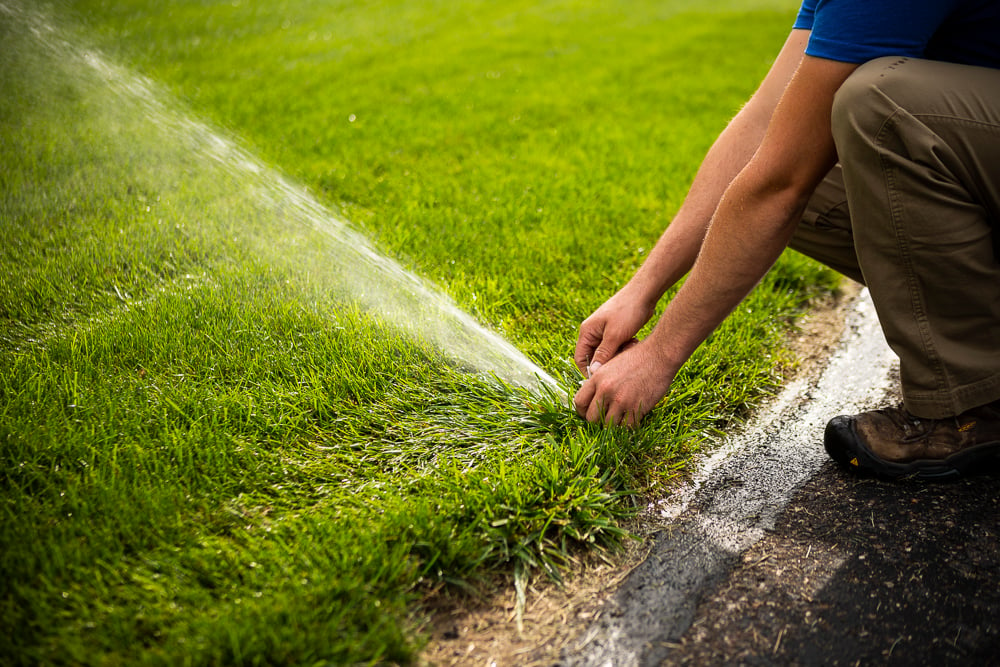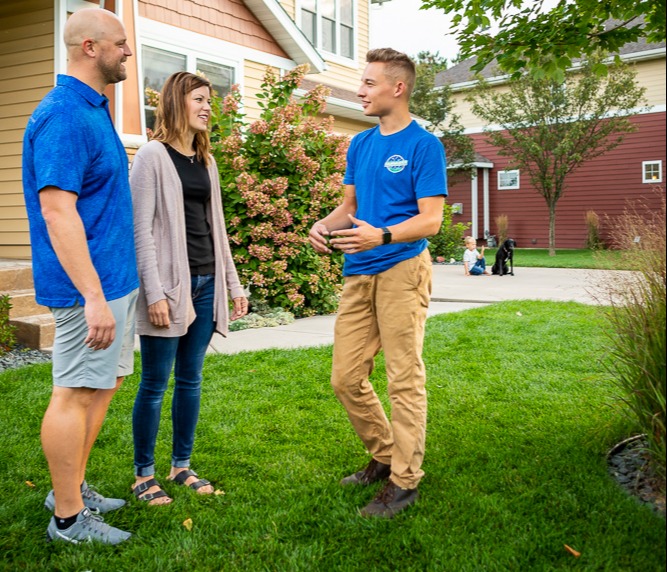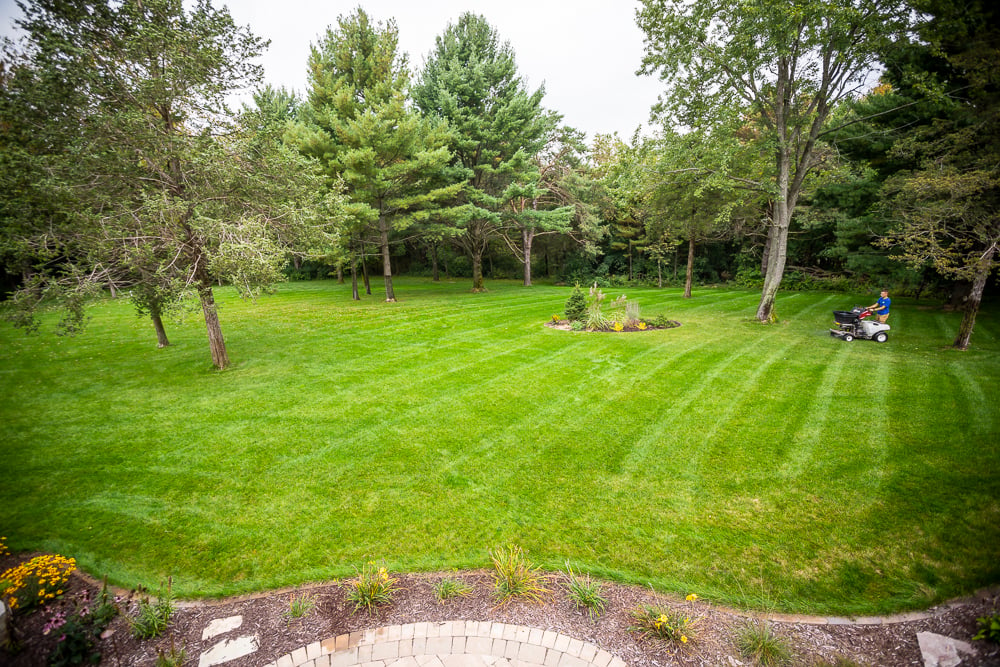If you’ve ever stood in the middle of the lawn care aisle at your local home improvement store and wondered how you got yourself into this predicament, you’re not alone. Caring for a new yard can be overwhelming.
Jump to Section
- What Are the Basics of Professional Lawn Care?
- What Are the Most Common Lawn Issues in Minneapolis?
- Is Professional Lawn Care Worth the Cost?
- How Do I Choose the Right Lawn Care Company?
- What’s Included in Professional Lawn Care Programs?
- FAQ About Professional Lawn Care Services in Minneapolis
- Choosing the Best Lawn Care in Minneapolis & Eau Claire
Whether you’re looking to get your lawn in shape or keep it looking pristine, there are so many questions to think about:
How do I mow? What does my lawn need to look its best? What products do I use? How much do I apply and when? Do I need to reapply?
It’s enough to make your head spin. So let’s start with the basics.
What Are the Basics of Professional Lawn Care?
Let’s start at the beginning. There are a few lawn care basics you’ll want to add to your chore list: mowing, watering, weeding and fertilizing.
Mowing
It might be tempting to mow your grass low so that you don’t have to haul out the mower as often, but mowing too short can starve your grass. Try to keep each mow to removing less than a third of the blade each time you make a pass.
Watering
Grass needs sun, soil and water to survive, but too much water can drown roots, so you don’t want to irrigate too often. Water deeply and less frequently to encourage strong roots. And be sure to water in the morning to reduce the risk of disease.

Weeding
A healthy lawn is the best defense against weeds, but if you start to see unwanted visitors like crabgrass popping up, you may want to consider a weed control application.
Fertilizing
A hungry lawn is not a happy lawn, so apply a fertilizer at least once before Memorial Day and three or four times after that.
What Are the Most Common Lawn Issues in Minneapolis?
At RainMaster, the three most common issues we see are:
- Brown Spots
- Weeds
- Thin Grass
Brown Spots
Brown spots in lawns can mean a lot of things.
They can mean your lawn is simply thirsty, which is easy enough to fix. But they could also mean that your lawn has a fungus, a disease or an improper pH balance. It could even mean that your mowing technique is off.

That makes it easy to misdiagnose the issue and put down the wrong product. If you think your lawn is dry, but it really has a fungal disease, you could be spreading the disease around when you increase irrigation.
It's critical to make sure you know the source of the issue before trying to treat it.
Weeds
It takes the right herbicide AND the right timing to get rid of pesky weeds in the lawn.
Be sure to read the instructions and consider applying a pre-emergent herbicide to stop weeds before they start.
Thin Grass
A thin lawn is susceptible to diseases, insects and weeds, so you want to fix patchy areas quickly.
Remember, the best defense against lawn issues is a strong, healthy stand of turf. But how do you know if the problem is imbalanced pH or compacted soil? What if it’s underfertilized or needs to be overseeded?
Make sure you know the source of the issue before starting treatment.
Is Professional Lawn Care Worth the Cost?
It might be easy to tell that your lawn is struggling, but the real question is why. Like we mentioned above, you’ll want to know the source of any issues before you take action.
A professional lawn care program will save you the hassle of guessing what’s wrong with your lawn and reduce the risk of accidentally damaging your grass.

Trained lawn care technicians know exactly which products to use, how to apply them, how much to use and how often to reapply.
That means fewer trips to the home improvement store and less time digging through your garage for lawn care supplies. Outsourcing all of that work to the pros means you’ve already checked lawn care off of your to-do list.
How Do I Choose the Right Lawn Care Company?
Begin with the basics when starting a new lawn care program and make sure the company shows you they care about their customers.
Ask yourself questions like: Do they answer the phone when you call or respond to your email in a timely manner? Are they helpful and informative?
That first interaction can tell you a lot about how a company is going to treat you once you become a customer.

Communication is key throughout the process. Think about things like: Are they trying to sell you services you don’t want or need? Are they walking you through the steps and making you feel comfortable with your options? If you aren’t looking for picture-perfect grass and just want the basic service, do they have an option for you?
Keep considering the quality of service throughout your contract. Do they let you know when to expect a technician or are you surprised when you find a stranger in your backyard? Do they ask you if you have concerns and follow up after they visit? Do they let you know when they need to reschedule due to bad weather?
And, of course, the final question is: Are the results what you’re looking for? Any good lawn care company will discuss any issues with you and make sure you’re happy with the results.
What’s Included in Professional Lawn Care Programs?
A good lawn care company should offer more than one program to cater to their customers’ needs. If you don’t need your lawn to look like a golf course, there should be an option for basics. And if you do want that country club look, there should be an option for that too.
But every program should start with a visit to assess your situation. They should also include a pH test at the beginning, as product applications won’t work correctly if the lawn’s pH is off.

Professional lawn care services in Minneapolis should include weed control, particularly for crabgrass, to prevent weed invasion, as well as fertilizer applications to enhance your lawn’s root system, color, and thickness.
From there, it’s up to the lawn tech to know if your yard needs more.
FAQ About Professional Lawn Care Services in Minneapolis
What are the benefits of starting professional lawn care services?
Professional lawn care services can save you time, money, hassles, and the risk of damaging your lawn by using the wrong products.
How much does lawn care cost in Minneapolis?
Lawn care in the Minneapolis area starts around $500 to $700 per year and can increase from there, depending on the services you want.
How many visits do I need?
It’s all about quality over quantity, so it’s important to note that paying for 10 visits isn’t necessarily going to bump up your lawn performance more than, say, five or six. Every lawn pro should tailor their program to provide your lawn with the nutrients it needs every season. Look at the amount of fertilizer you’re getting, not the number of visits.
How much does lawn care cost in Minneapolis?
The cost of lawn care programs varies depending on which services the package includes, the number of visits and the size of your lawn.
On average, you can expect to spend between $500 and $1,000 a year for a 5,000-square-foot lawn.
When is the best time to start a new lawn care program?
It’s never too late to help your lawn get a head start on next year. Removing every weed from your lawn in the fall improves its performance the next spring.

Fall is one of the best times to do a lawn renovation since you’ll have time to wipe out weeds and give the grass time to fill in. In the fall, cool-season grasses have the optimal temperatures to thrive. And since weeds are storing up nutrients for the winter, they’ll soak up herbicide and die out.
Is professional lawn care safe for children and pets?
Yes! If you take the proper precautions and wait the recommended amount of time (usually about an hour) after your lawn tech visits, you, your kids and your pets have nothing to worry about.
Choosing the Best Lawn Care in Minneapolis & Eau Claire
At RainMaster, we offer three levels of customizable programs to help you find the right option for your lawn and your budget. As you can see, proper lawn care can eat up a lot of time – time you’d likely rather spend relaxing with your family and friends.
Let our experts take care of the yard work
so that you know your lawn is in good hands.

Luscious Lawn
Optimize your lawn’s performance with the complete package that includes everything a lawn needs to get and stay healthy.
Terrific Turf
Take a proactive approach to lawn care with a mid-level option that can take on the most common lawn care needs.
Healthy Habitat
Control weeds, boost nutrition and manage pH with this basic approach that includes the essentials for a healthier, greener lawn.
Are you ready to enjoy a lush lawn without all of the hard work? Request a free quote today! We’ll discuss the options and find the right lawn care lawn care program for you. Then, you can just sit back and relax, knowing your lawn is in good hands.




